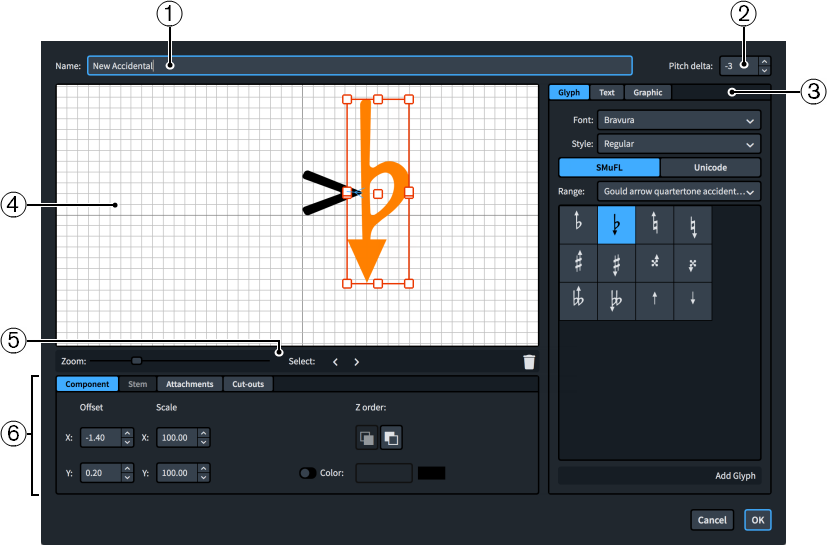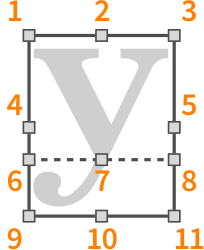Edit Accidental dialog
The Edit Accidental dialog allows you to create new and edit existing custom accidentals.
-
You can open the Edit Accidental dialog by clicking either New Accidental, Duplicate Accidental, or Edit Accidental in the action bar at the bottom of the Accidentals section of the Edit Tonality System dialog.

The Edit Accidental dialog contains the following sections:
-
Name
Allows you to enter a name for your accidental.
-
Pitch delta
Allows you to set a value for how much the accidental raises/lowers the pitch of notes. For example, in 12-EDO, a pitch delta of 2 raises notes by two equal divisions of the octave.
NoteWe do not recommend setting pitch deltas that are more than half of the total number of octave divisions.
-
Accidental component selector
Allows you to choose components to add to your accidental. You can add different types of components by clicking the respective tab titles.
-
Glyph, for example, ♮ or ♯. You can use different styles of glyphs by selecting different fonts and font styles/weights from the menus. You can search using SMuFL or Unicode ranges. Click Add Glyph to add the selected glyph to the accidental.
NoteA full list of the different ranges of glyphs is available on the SMuFL website.
-
Text, including numbers and other text. You can use numbers and text from the available Preset text list or select any font available from the menu and enter your preferred text into the text box at the bottom. Click Add Text to add the selected or input text to the accidental.
-
Graphic: Allows you to load a new graphics file or select an existing graphic from the Select existing list in SVG, PNG, or JPG format. You can see a preview of the graphic in the Preview box. Click Add Graphic to add the selected graphic to the accidental.
-
-
Editor
Allows you to arrange and edit the components that make up your accidental. You can use the controls at the bottom of the dialog to edit and arrange accidental components.
-
Editor action bar
Contains selection and view options for the editor.
-
Zoom: Allows you to change the zoom level in the editor.
-
Select: Allows you to select the next/previous component.
-
Delete
 : Deletes the selected component.
: Deletes the selected component.
-
-
Controls
Contains controls that allow you to edit individual components. Controls are divided into tabs according to the aspect of the selected component they affect. For accidentals, the Component, Attachments, and Cut-outs tabs are available.
The Component tab contains the following options:
-
Offset: Controls the position of the selected component. X moves it horizontally, Y moves it vertically.
-
Scale: Controls the size of the selected component. For graphics, X controls its width, Y controls its height.
NoteAlthough some components scale their height and width independently, others retain their aspect ratio, meaning only one value affects their overall size.
-
Z order: Allows you to Bring Forward or Send Backward the selected component in relation to other components when they overlap.
-
Color: Allows you to change the color of the selected component.
The Attachments tab is only available if the accidental comprises at least two separate components. It contains the following options:
-
Attachment from: Sets the attachment point on the component to the left of the selected component to which the selected component attaches. We recommend that you select a right edge attachment point for Attachment from.
-
Attachment to: Sets the attachment point on the selected component which attaches to the component to its left. We recommend that you select a left edge attachment point for Attachment to.
The Cut-outs tab allows you to mark individual corners within an accidental component that can overlap with other accidentals, for example, in order to position accidentals closer together in dense chords. It contains the following options for each of the four corners, which are labeled according to their compass direction:
-
Width: Sets the width of the cut-out area.
-
Height: Sets the height of the cut-out area.
-
Add
 : Adds a cut-out to the corresponding corner.
: Adds a cut-out to the corresponding corner. -
Delete
 : Removes the cut-out from the corresponding corner.
: Removes the cut-out from the corresponding corner.
-
There are eight attachment points for glyphs and graphics, and eleven for text, due to the extra space required for letters that extend below the baseline. The example diagram helps you visualize how these points relate to components.

The attachment points have the following names in the Edit Accidental dialog:
-
Top Left
-
Top Center
-
Top Right
-
Middle Left
-
Middle Right
-
Baseline Left (text only)
-
Baseline Center (text only)
-
Baseline Right (text only)
-
Bottom Left
-
Bottom Center
-
Bottom Right